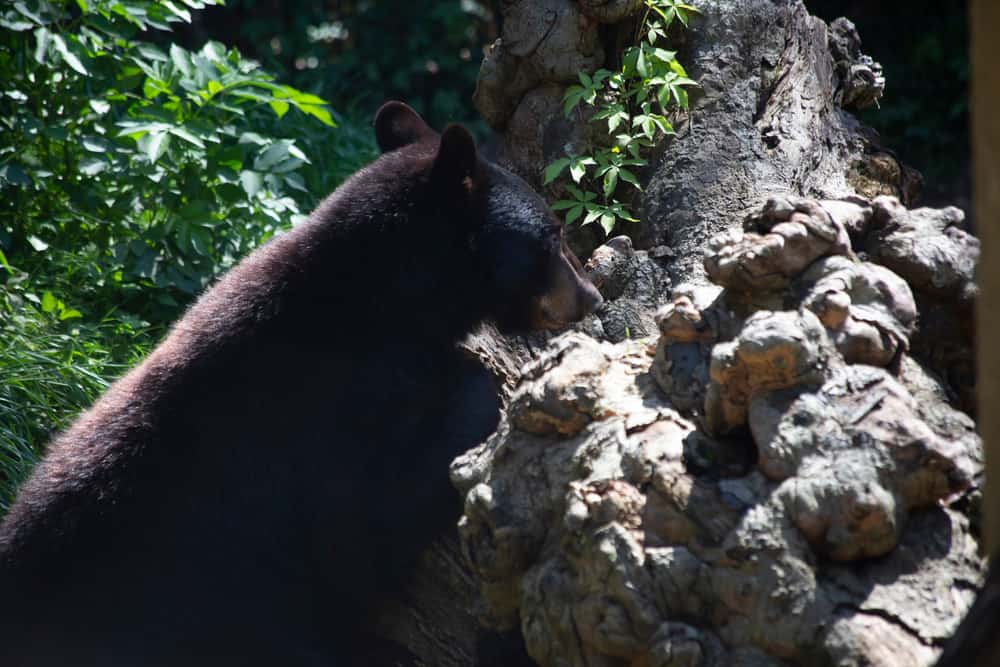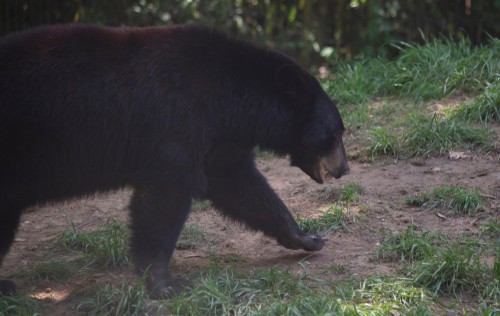Louisiana is home to one of 16 unique subspecies of the American black bear called the Louisiana black bear (Ursus americanus luteolus). The Louisiana black bear, also sometimes referred to as Teddy’s bear, is Louisiana’s official state mammal.

Louisiana black bear description
There are a couple of small phenotypical differences between Louisiana black bears and other subspecies of black bears. They are that, on average, their skull is longer, and flatter, and their molars are proportionately larger.
General black bear characteristics
There are 16 distinct black bear sub-species, and they all reside in North America. The United States has 2 other bear species, which are brown/grizzly bears and polar bears. Both of these reside in Europe and Asia, as well as North America.
Adult black bears vary from 50 to 85 inches long from the tip of the nose to the tail. Their average height is around 30 inches at the shoulder. The normal black bear’s weight range is from 140 to 400 pounds. However, adult males can be up to 70% larger than females, and some giant-sized individuals weigh over 800 pounds. The heaviest black bear ever harvested came from Pike County, Pennsylvania. It weighed 875 pounds.
Even though they are named black bears, their color can vary from black. Some black bears are blue-grey, cinnamon, brown, blue-black, and on infrequent occasions, a black bear can even be white. Although most Louisiana bears are black, a small percentage of them are tan or cinnamon-colored. Some black bears have a V-shaped white patch on their chest.
They have long brown snouts with a broad nose pad and large nostrils, short tails, and small brown eyes, although their eyes are blue at birth. Black bears don’t have a shoulder hump like brown bears or grizzly bears do. In areas that both species inhabit, the hump, or the lack thereof, is a distinguishing feature. Any wild bear in Louisiana will be a black bear, though.
There’s some debate over how well black bears see. However, there’s no denying that they have exceptional auditory and olfactory senses. Their hearing is twice as sensitive as that of a human. What’s more, their sense of smell is particularly strong in that they can smell up to seven times better than a bloodhound.
Although black bears appear to be slow and ponderous as they forage for food, they have the ability to run 30 to 35 miles per hour in short bursts and can climb straight up a hundred feet of tree in about 30 seconds. See
Black bears are omnivorous. Their diets have been documented to consist of up to 96% plant material such as nuts, acorns, fruit, berries, grasses, and forbs. They also feed on ants, larvae, and small mammals.
At around three to four years old, a black bear is mature enough to mate. Females usually only get pregnant every other year. This depends on food sources because if the food is scarce, they may wait an additional year or two until they mate again. Like in other bear species, female black bears have delayed implantation, which means that the embryo(s) do not attach to their uterus until fall when they go to hibernate. Black bears have1 to 4 cubs, and they tend to stay with their protective mothers until they are a year and a half to two years of age. See
In the wild, individual bears live up to 20 years.

Louisiana black bear habitat
Black bears primarily live in forested areas. In Louisiana, they live in hardwood bottomlands which are mostly in the Mississippi River alluvial valley.
Since recovering from near extinction, they are broken up into 3 main populations. One is in the Tensas River basin. There is also a population in the upper Atchafalaya River basin and another in the lower Atchafalaya River basin. There is some controversy surrounding the upper Atchafalaya River basin population. We’ll get into that later.
History of the Louisiana black bear
Prior to the time of European colonization, the population of the Louisiana subspecies of black bears numbered at least 80,000. Their historic range once covered 120,000 square miles or more. It stretched from eastern Texas through all of Louisiana and into southwestern Mississippi. It also ran north into southern Arkansas.
However, by the early 1900s, overhunting and habitat degradation had greatly diminished the Louisiana black bear population. Consequently, they were relegated to a small fraction of their former range in the Mississippi alluvial valley.
In 1902, the Louisiana black bear became part of American culture and garnered some association with the man who many consider to be the father of conservation ethics in the United States.
President Theodore Roosevelt went to the Mississippi delta region on a hunting trip. While there, he refused to shoot a Louisiana black bear that had been trapped and tethered to a tree because he deemed it to be unsporting. Sentimentality over this event led to it being depicted in a cartoon strip in the Washington Post. Subsequently, the cartoon strip gave a Brooklyn candy-store owner the inspiration to invent the teddy bear.
In the 1960s and 1970s, Louisiana black bear habitat loss was accelerated due in part to the price of soybeans. At this time, soybean prices were at an all-time high. Consequentially, farmers cleared thousands of acres of private lands that consisted of bottomland hardwood forests of Louisiana in the lower Mississippi alluvial valley and converted them into soybean production.
By the early 1980s, Louisiana’s black bear population was on the brink of extinction. There were fewer than 120 of them left.
Louisiana black bear recovery plan
In 1992 Harold Schoeffler from Lafayette, Louisiana, filed suit in a U.S. district court to compel the U.S. Fish and Wildlife Service to put the Louisiana black bear on the endangered species list.
In 1992 the U.S. Fish and Wildlife Service gave the subspecies of the American black bear, known as the Louisiana black bear, protection under the endangered species act of 1973 as a threatened species. There are two different classifications under the Endangered Species Act. endangered species are on the brink of extinction, while threatened wildlife are likely to become endangered in the foreseeable future. The protections for each are similar.
Since 1992 the Louisiana Department of Wildlife and Fisheries, along with a broad array of partners, has worked to preserve and/or restore over 750,000 acres of black bear habitat. This includes incentivizing farmers to convert difficult-to-farm lands back into hardwood forests. See
The U.S. Fish and Wildlife Service set up the following recovery criteria that the Louisiana black bear population had to meet before it could be removed from the endangered species list.
- At least two viable subpopulations, one each in the Tensas and Atchafalaya River basins.
- Immigration and emigration corridors between the two subpopulations.
- Protection of habitat and corridors that support the two subpopulations.
To meet the above criteria, the USFWS and its state and private partners have done the following.
- Incentivized farmers to convert difficult-to-farm lands back into hardwood forests. See
- Public lands that include national wildlife refuges, wildlife management areas, and U.S. Army Corps of Engineers lands that are suitable habitat Louisiana black bears are now protected from future development and managed in a way that benefits bears.
- The Louisiana Department of Wildlife and Fisheries, the U.S. Fish and Wildlife Service, and the U.S. Geological Survey, collaborated to develop a database that they use to track bear occurrences, captures, and mortalities to better manage the subpopulations.
- After removal from the endangered species list, bears will remain protected by Louisiana state laws.
Delisting proposal
Since 1992 Louisiana black bear numbers have steadily increased. Consequently, in 2015 the USFWS determined that all of the recovery criteria that were set out in the 1995 Louisiana Black Bear Recovery Plan, had been met. They also determined that any threats to the bear had been reduced or eliminated. In 2016 the USFWS removed the Louisiana black bear from the endangered species list. At this point, the state of Louisiana assumed all management responsibilities.
A conservation success story
Maria Davidson, who is the Large Carnivore Program Manager for the Louisiana Department of Wildlife and Fisheries along with Deborah Fuller and David Soileau from the U.S. Fish and Wildlife Service, received the distinction of 2015 Recovery Champions for the USFWS’s Region 4 due to the part they played in the Louisiana black bear’s recovery and its removal from the endangered species list.
From the LDWF website, “The goal of the LDWF is to maintain a sustainable black bear population in suitable habitat throughout Louisiana for the benefit of the species and Louisianans. Bear management and conservation strategies include public education, research, population management, and habitat restoration.”
Lawsuit
The U.S. Fish and Wild Service delisting the Louisiana black bear isn’t the end of the story. In 2018, the plaintiffs, Atchafalaya Basinkeeper, Louisiana Crawfish Producers Association West, Sierra Club and its Delta Chapter, Public Employees for Environmental Responsibility (PEER), Healthy Gulf, and individual plaintiffs, Ronald M. Nowak, Dr. Michael J. Caire, and Harold Schoeffler sued the U.S. Fish and Wildlife Service in the Middle District of Louisiana United States District Court to compel them to place the Louisiana black bear back on the endangered species list.
In their legal brief, the plaintiffs claim that the USFWS has not actually met the criteria that it originally set out for delisting of the Louisiana Black Bear. That being two viable populations, one being in the Tensas River Basin and the other being in the Upper Atchafalaya River Basin, with a connecting migration/immigration corridor in between allowing the two populations to interbreed.
The connection of the populations was achieved with a 2001–2009 program to translocate some TRB bears to an area between the two populations, known as the Three Rivers Complex. Upper Atchafalaya River Basin bears moved into the Three Rivers Complex, and interbreeding began just as the planners had hoped.
Minnesota black bears
According to the plaintiffs, there is a problem, though. Although the bears in the Tensas River Basin and the Lower Atchafalaya River Basin are true Louisiana black bears, the bears in the Upper Atchafalaya River Basin are not.
They are descended from bears of another subspecies, that were introduced from Minnesota in the 1960s by the Louisiana Department of Wildlife and Fisheries to increase the black bear population for sport hunting.
If this is the case, the Louisiana black bear recovery plan has recovered and preserved many acres of bottomland hardwood forests. It has also saved the black bear from expatriation in Louisiana. On the other hand, it has created a means to hybridize the true Louisiana black bear sub-species.
Depending on who you are and what you value, retaining the genetic purity of a sub-species with big molars and a longer head may or may not be important.
To some, the important thing will be to retain black bears in the state regardless of the subspecies designation. It’ll be interesting to see how this plays out.
You might also like: Wild Cats In Louisiana
Recent Posts
The only venomous snakes in Washington State are Northern Pacific Rattlesnakes. The Northern Pacific Rattlesnake (Crotalus oreganus oreganus) is a sub-species of the Western Rattlesnake. Anyone...
Skunks are not classified as true hibernators. But they go into a state of torpor when the weather gets cold. Skunks are light sleep hibernators, along with opossums, bears, and raccoons. ...

